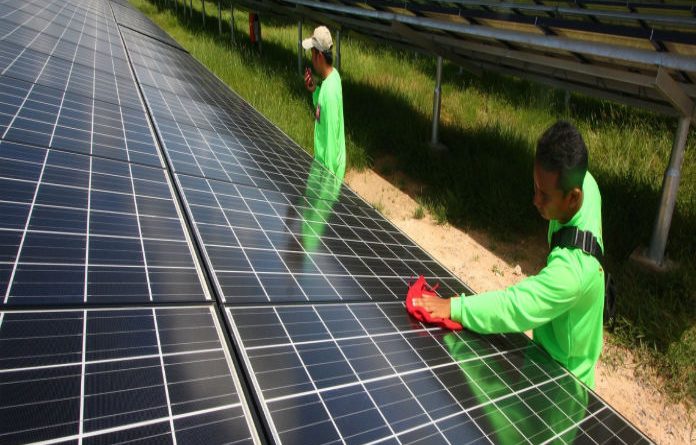World Bank Group activities to address climate and environmental challenges
In our last fiscal year, the World Bank Group committed $17.8 billion to climate-related investments. We also have a major portfolio in other environment-related projects. In December, we announced new climate targets for fiscal year 2021-2025, committing to double to $200 billion the amount we invest and mobilize. We’re already the biggest single funder of climate and environment investments, and we’re ramping up. In fiscal year 2019, 30 percent of commitments by the IBRD and IDA included climate co-benefits, surpassing our target.
The scale of our commitments reflects our belief that investing in climate and the environment is a key step in reducing extreme poverty and boosting shared prosperity. Our climate and environment projects unlock new growth and investment opportunities, create jobs and make economies more resilient. It’s important to change mindsets and lead the way. Here’s an overview of what we’re doing:
Deforestation and biodiversity:
At the U.N. next week, I’ll speak at an event on deforestation and the Amazon, and will announce an innovative partnership to restore degraded land and stop deforestation. I’ve discussed the Amazon crisis with the Brazilian authorities, as well as with G-7 leaders at the recent summit in Biarritz, France. At the World Bank Group/IMF Annual Meetings next month, we’ll host a meeting of the countries of the Leticia Pact for Amazonia to support their plan to promote sustainable management of the Amazon.
We plan to showcase the importance of biodiversity at the Annual Meetings at an event on October 17 called “Invest in Nature: Uncovering the Hidden Value of Biodiversity.”
We see natural capital as an economic catalyst and cost-effective buffer against climate extremes. Our “Changing Wealth of Nations” report found that natural capital makes up nearly half the wealth in low-income countries. Our estimate will likely go up in the next version of the report, which will capture other dimensions of natural capital for the first time, such as the benefits provided by oceans.
We helped Ethiopia transform degraded environments into green and productive land, putting 900,000 hectares of land under conservation and giving 2.5 million people food security, better water access and higher crop yields.
Adaptation and resilience:
On Monday, I’ll speak about resilience and adaptation at the U.N. climate summit. Adaptation can generate a huge return on investment. Investing $1.8 trillion in just five sectors from 2020 to 2030 could generate up to $7.1 trillion. The five sectors are: early warning systems, climate-resilient infrastructure, dryland agriculture, mangrove protection and resilient water resources.
Earlier this year, we launched the Adaptation and Resilience Action Plan, which focuses on three actions:
- boosting our own adaptation financing to $50 billion;
- helping countries adapt so that climate risks are managed at every phase of policy planning, investment design, and implementation; and
- developing a new rating system to create an incentive for investments in adaptation and resilience, and to improve tracking.

The IDA-funded Cities and Climate Change Project rehabilitated and/or constructed 11 km of drainage canals, installed flood control stations and built a large retention basin in the city of Beira in Mozambique. This helped reduce the risk of flooding in the city, especially during Cyclone Idai. Photo: © Sarah Farhat/World BankWhat does that look like at the country level? In Sierra Leone’s populous coastal area, a transport project is strengthening the roads and highways most vulnerable to floods. This is creating a robust mobility system that’s more resilient to flash floods and landslides. We’re also boosting public transport so people can get to schools and jobs more quickly while reducing emissions. This effort will help 75,000 transit riders–nearly 40 percent of whom are women.
In Mozambique, after the Idai and Kenneth cyclones that affected millions of people, the government led a crisis response involving 1,000 aid workers from 188 organizations. The World Bank worked with the government, U.N. agencies and donors to coordinate the response. Within one month of Idai’s landfall, over a million people received food assistance, some 907,000 received clean water, and 745,000 were vaccinated against cholera. I had the opportunity to visit the port of Beira soon after the cyclones hit, and found it back in operation and the city cleaned up. This was partly thanks to a World Bank co-investment with Germany’s KfW for a stormwater drainage system whose 11 kilometers of canals and flood control systems prevented the city from flooding. The project includes solar-powered street lighting, which at one point was the only source of light in the city.
To help the cyclone recovery, we announced nearly $700 million in support for Mozambique, along with Malawi and Zimbabwe. Mozambique received a commitment of $350 million from our IDA Crisis Response Window to re-establish the water supply and rebuild damaged public infrastructure and crops. The financing supports disease prevention, food security, social protection, and early-warning systems in the impacted communities.
Climate-smart agriculture:
Climate-smart farming is critical to helping farmers adapt to challenging growing conditions. Better agricultural practices are also key to protecting biodiversity. The West Africa Agricultural Productivity Program developed and distributed 160 climate-smart crop varieties to farmers, and trained farmers on climate-smart practices such as composting and agroforestry. Climate-smart agriculture will feature as part of the mix of solutions discussed at the Annual Meetings at an event called “The Future of the Rural Space” on October 16.
Working with the Consultative Group for International Agricultural Research (CGIAR), the World Bank is stepping up agricultural research in Africa, with a strong focus on drought-resistant seeds. We’ll work with our partners in Africa to develop a new IDA financing package of $60 million. Together with our ongoing contributions to CGIAR, we expect to provide agricultural research support through this mechanism on the order of $150 million over the next three years.
Renewable energy:
The World Bank is committed to helping countries accelerate their energy transition and deliver sustainable, reliable, affordable energy.
Over the past 11 years, IFC has financed more than 5 gigawatts of solar power worldwide, supporting solar projects in more than 15 countries. Scaling Solar, a joint IFC and World Bank program, is expanding to five countries in Africa and one in Central Asia. In Zambia alone, Scaling Solar has added 88 megawatts of power.
During my recent visit to Egypt, I visited the massive Benban solar plant just outside of Aswan. This will be the largest solar plant in the world–built in less than two years with over $2 billion of private sector investment led by IFC. Egypt’s energy reforms opened the door to private sector investments and could be replicated in other climate-related areas.
The World Bank is supporting India with a major energy initiative with $1 billion in lending, and working to scale up its energy-efficiency program on a national level.
Last September, the World Bank committed $1 billion to accelerate investments in battery storage for power systems in low- and middle-income countries. This investment is intended to increase developing countries’ use of solar and wind power, and improve grid reliability, stability and power quality while reducing carbon emissions. The program aims to finance 17.5 gigawatt hours of battery storage by 2025, more than tripling the amount currently installed in all developing countries.
In Haiti, one of the most electricity-deprived countries in the Caribbean, we’re working on a combined solar and battery-storage project that will provide clean energy for 800,000 people and 10,000 schools, clinics and other institutions.
Sustainable cities:
A big share of our work on adaptation is happening in cities, many of which are close to coasts and thus vulnerable to climate change. Cities are also major consumers of energy, and they emit 70 percent of greenhouse gases. The World Bank’s work in urban development aims to build sustainable cities and communities, helping national and subnational governments meet the demands of urbanization in a way that’s inclusive and resilient, while still being productive and livable.
By harnessing the power of digital technologies, we can assess natural hazards in a city and map people and assets. We can analyze climate and disaster risks in order to plan and finance more resilient cities. For example, drones offer the potential to produce maps of Zanzibar in six months, allowing officials to monitor urban expansion, locate areas of flood impact, and track properties to enable collection of property taxes. With satellite imagery and radars, working with the European Space Agency, we’re able to measure the land subsidence of Jakarta, which in some areas reaches as much as 15 centimeters per year due to excessive groundwater extraction.
Urban infrastructure financing needs greatly exceed fiscal and commercial financing resources. The World Bank assists cities by investing directly in urban infrastructure and helping national and municipal governments build fiscal and financial systems to expand revenues and give more access to private capital to finance investment needs sustainably.
Water and waste:
Our new water report makes clear that worsening water quality could cut a third of potential economic growth in polluted areas and threaten human and environmental well-being.
Eighty percent of the world’s wastewater is released to the environment without treatment, and 1.6 million people die each year from diseases related to poor sanitation and hygiene. We’re helping governments manage their water resources so they can deliver clean water and sanitation services to families, farms and factories.
Since 2000, the World Bank has committed over $4.7 billion to more than 340 programs in countries across the globe, financing solid waste management, recycling, clean production, and policy reforms to assist carbon pricing and green growth.
In Azerbaijan, World Bank loans supported the rehabilitation of the main landfill site and the establishment of a waste management company. The share of the population served by the formal solid waste management system increased from 53 percent in 2008 to 74 percent in four years.
Pollution and marine plastics:
Air, land, and water pollution cause an estimated 9 million premature deaths worldwide. Ambient air pollution cost the global economy the equivalent of $5.7 trillion in 2016 – 4.8 percent of global GDP. Our new PROBLUE program promotes sustainable economic activities in healthy oceans. We’re ramping up work across the globe to address marine plastics and other threats to ocean health, such as overfishing and the destruction of natural habitats such as mangroves. In Indonesia, the World Bank contributed $100 million to the country’s $1.3 billion waste-management program, including investments in marine litter management.
New financing solutions:
The private sector will be critical in addressing climate and environmental challenges. The World Bank Group has been a pioneer in financing solutions for climate and the environment. We issued the first labeled green bond in 2008 and have since raised about $13 billion through more than 150 green bonds in 20 currencies for institutional and retail investors around the world.
We developed tools like the Catastrophe Deferred Drawdown Option, a contingent loan with a rapid-disbursement mechanism in the event of natural disaster. We’re working with countries through regional programs that pool risk and transfer it to financial markets to lower the cost of premiums and establish regional platforms for risk models and collaboration around preparedness. The first of these regional risk financing facilities, the Caribbean Catastrophe Risk Insurance Facility, now includes 21 Caribbean and Central American countries that can access insurance against earthquakes, tropical cyclones, and excess rainfall. The facility has made 39 payouts totaling $150 million, including $11 million disbursed quickly to the Bahamas after Hurricane Dorian.
This is a selection of the many ways in which the World Bank Group is working to address climate and environmental challenges around the world. I look forward to discussing these important issues at the U.N. next week and our Annual Meetings in October.




